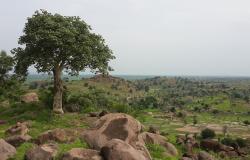Glimmers of Confidence in Pibor, South Sudan – where the Triple Nexus Grows Unscripted

This is the tenth chapter in a forthcoming e-book, entitled 'The Triple Humanitarian, Development and Peace Nexus: In Context and Everyday Perspective', edited by Marina Ferrero Baselga and Rodrigo Mena. Chapters are currently being serialised on Global Policy.
This chapter focuses on an indirect perspective of the Triple Nexus, not necessarily as a well-designed programmatic approach, but rather as a spontaneous and grassroots phenomenon. It shows how linking humanitarian, development, and peace approaches naturally occurs in the everyday lives of people affected by crises. By observing their strategies to address their struggles, we can see a Triple Nexus approach taking root and evolving organically, even without being explicitly labeled as such. This chapter, therefore, demonstrates how innovation in humanitarian responses naturally connects to development and peace components through the actions of local actors. While later international actors may label and frame these efforts within the Triple Nexus concept, it is crucial to recognize the more natural, spontaneous, and even 'common-sense' manifestations of the Triple Nexus among people in crises.
Scorched earth…, or not?
Imagine you live in a place that is attacked on a regular basis by armed youth groups from neighboring areas. Where your home is flooded for half the year, then scorched by drought. Where clean water is scarce, food insufficient, and diseases like malaria and measles are constant threats. Where your sister has been abducted, your uncle’s cows stolen, and your little brother died of hunger. What if your father tells you that this is normal—that it has always been this way? But what if there is another way?
Is doing good helping?
Though severely challenged by security constraints, humanitarian and development agencies have done amazing work in Pibor, a remote town in eastern South Sudan. It has focused mainly on short-term alleviation of basic needs and suffering related to food security, malnutrition, and health. This highly important work has been limited in scale and mandate due to the social and political instability of the area. For years, mainly NGO’s and UN agencies were active in the area, such as Médecins Sans Frontières and the World Food Program.
Today, several local NGO’s such as Across and Nile Hope, as well as INGO’s like Help a Child, ZOA, CARE, and Plan International are actively involved in various humanitarian sectors, including Child Protection, Water, Sanitation, and Hygiene (WASH), as well as Food Security and Livelihoods. Moreover, there has been a shift from relief efforts toward resilience building: for example, instead of providing only food distributions, organizations now often combine this with providing seeds and tools. This is combined with agricultural training on soil management, weeding, crop management, rotation, seed harvesting and more. Ownership, less dependency on foodstuffs, and skills-building. Still, every year large amounts of very expensive foodstuffs and agricultural tools are shipped into the area by NGOs. As a program coordinator, I thought: Is this helping? Is this addressing the causes of conflict? Are we truly supporting resilience-building? And I had to conclude that the answer, in many cases, was ‘No’...
Another approach was needed: to continue in the same way would undermine local self-reliance, ownership, and dignity. It would strengthen the dependency on humanitarian and development actors. But how to change this?
Casting the net
Our local partner, Across, realized that there was an untapped resource in the area: fish. Given the severe flooding every year, fish are abundant, even when food insecurity is high. The Across staff—who are not from Pibor—had observed that local people sometimes catch a fish, eat some of it on the shore, and throw the rest away. In consultation with local leaders and communities, Across suggested an innovative and entrepreneurial project: setting up a flexible fish value chain.
This would involve catching, sun-drying, grinding, packaging, labeling, and selling the fish in and outside of Pibor, since fish powder is widely used in South Sudan as a cooking ingredient. After approval by the local chiefs and communities, a program was started that focused on a small group of women becoming fish entrepreneurs, with the involvement of youth and men. After careful initiation with the community—of which the design and approval phases were an integral part—women were trained in drying, smoking, grinding, packaging, labeling and selling the fish. Youth and men were trained to catch and prepare the fish.
The selling was mainly done on the local market, but there is interest from traders in Bor and Juba. In stable times, this means economic ties with areas outside of Pibor can be strengthened and increased, decreasing dependency on the annual traders that come to the areas with expensive goods such as utensils and clothing. During unstable periods, fish can still be sold at the local market, or processed at homes if the security situation doesn’t allow selling or gathering in the markets.
What came out of the net
What Across exemplified, was the invaluable importance of engaging the community in all stages of this process. As a local organization Across is experienced in this; they take the time and effort to engage in community-wide engagement meetings several times a year, independent from any new project, donor or deadline. By prioritizing empathy, connection, and genuine value for the people they work with, they're not just addressing surface-level issues—they're living alongside the community, experiencing daily challenges and triumphs firsthand.
A key aspect in this is building rapport and trust with local chiefs, traditional and religious leaders in the areas. This enables organizations to introduce new ways of working, for instance, by prioritizing women as the main actors in the program. The INGO, Help a Child, learned a lot from this approach and adopted this way of working in other areas, such as Wau. At this very moment, similar initiatives in conflict-affected areas around Wau are being implemented by Help a Child, this time with groundnuts, chili and millet. These, too, are mainly focused on women and tailored to local perspectives, needs and realities.
Transformation through confidence
The local acknowledgement and involvement encouraged women to come together and learn new skills. Driven by the community-wide inception meetings and the approval of local leaders, it was one of the first programs in the area with women in the driver’s seat. Through this, they acquired many new skills such as building drying ovens, cutting and preparing the fish for drying, using a hand-powered grinding machine, and packaging and labeling the powder. And more importantly, they learned how to make plans, divide the work, cooperate, communicate their views, needs and wishes to each other as well as to the youth, men and local leaders. Across staff mentioned that, in fact, the most important change was the growth of self-esteem and confidence in women, in their skills, in their work, in their position in their community, in their ability to generate an income.
What about the impact on peace?
Based on regular feedback in accountability and monitoring activities, Across learned that the program contributed to peace in several ways. On a local scale, by bringing together women, men and youth in reaching the outcomes of the program. Where gender roles were strictly separated before—and women were not allowed to have any say in livelihood decisions—now women and men were working together to create new products and building their resilience. Though it was not part of the program or measured specifically, some community members expressed that the joint activities contributed to a reduction in domestic and gender-based violence. The Across staff mentioned that it is likely that the men realized that their wives and the women in the community in general, were ‘actually’ very capable and valuable for everyone’s livelihood. These realizations may have influenced common cultural gender norms and values, resulting in fewer instances of violence against women and girls.
In South Sudan, as in many conflict-affected settings, gender-based violence is both a symptom and a driver of broader cycles of violence. It is often used as a tool of control, exacerbated by poverty, displacement, and the breakdown of social structures. Reducing GBV not only protects the rights and well-being of women and girls, but also helps to rebuild trust, strengthen social cohesion, and support lasting peace within communities. When women participate safely and equally in economic and social life, the foundations for peaceful coexistence become stronger.
Another layer is related to the youth. In Pibor and surrounding areas, it is mainly the armed youth groups that engage in armed conflict. Very limited economic activities and widespread poverty make joining armed groups appealing as a coping strategy. Also, social and cultural norms place a strong emphasis on young people as warriors and protectors of their communities. These aspects, combined with a history of grievances and retaliatory violence, are normalizing conflict. One could go as far as to describe violence as part of the youth identity in the area.
During the program, young men were involved in catching and processing the fish. Although the program was brief and it is too early to assess long-term impacts, the successful outcome of the program suggests that young people might be incentivized to pursue peaceful economic activities. Diversifying livelihood options based on local resources and knowledge can help to become less dependent on common and traditional strategies such as cattle herding, raiding, abductions and fighting. And it is not only building on what is available in an inclusive and community-based way, it is challenging the community to explore new pathways for change that match the local reality.
Glimmers of confidence and perspective
Creating an enabling environment for equal participation of women and youth—that is basically what the community, leadership and NGOs did together. This was achieved by intentionally focusing on the connectors in a conflict situation: in this case, the leadership structures, the common need for improved food security, shared water resources, and the need to decrease dependence on traditional and livelihood modalities that are under pressure. Addressing needs through age sets, genders, and livelihood modalities, using local natural resources, and inviting the community to consider new directions for change enabled those in need to change their perspectives on the future and their role in it.
This was completely different from the ‘standard’ aid modalities of bringing in food, seeds and tools. Of course, they are all highly needed and should continue to be provided in where necessary. However, the involved team felt that during the new initiative there were glimmers of confidence, perspective and dignity for the women that were not there before. The intention is to build on this by having more initiatives focused on the youth, thereby, contributing to the socio-economic pillar of peacebuilding.
Much more is needed to address the essential pillars of security, good governance and to work on reconciliation and justice. Also, it will be vital to ensure the sustainable use of local natural resources to prevent a potential connecting element from becoming a divider instead. It is not my intention to present this initiative as a perfect model at all. It was only possible in combination with many efforts of other actors in the area, for example, those active in awareness campaigns on gender and women’s rights and programs.
Also, in this pilot project, we realized that we did not yet have a good and thorough understanding of peacebuilding frameworks and methods. We started out by exploring the (quite outdated) peacebuilding palette of Utstein as a starting point. Next steps were to reach out to peacebuilding organizations like PAX and other peacebuilding models, such as Multi-Track Diplomacy. This helped us to develop a more comprehensive view on peacebuilding, it also confronted our organization and consortium with the long road ahead for humanitarian and development actors in terms of integrating our work and approaches into it and truly engaging in the Triple Nexus.
But the glimmers of hope, confidence and perspective of the women and the youth taught those involved that only an integrated approach addressing short-term life-saving needs, addressing longer-term development needs and a modest contribution to social cohesion and peace was able to bring a breakthrough. It also gave the team more hope and confidence that, one day, food insecurity and malnutrition may be reduced, and approaches like this might be applied to facilitate pathways to other developmental outcomes, such as improved healthcare and education.
This chapter started by introducing the Triple Nexus not as a top-down, rather technocratic approach, but as a lived reality for people dealing with complexity daily. What emerged in Pibor, through the flexible value chain initiative, is an inspiring example of this. The project did not start out to “implement” the Triple Nexus. Instead, it developed more naturally by listening to local voices, responding to the most pressing needs and connecting to local capacities. The results, however modest and small scale, reflected a combination of humanitarian action, development thinking and peacebuilding potential. The results showed how ownership, dignity and inclusion can create small but important signs of transformation. In this way, the pilot project in Pibor shows that humanitarian, development and peacebuilding actors need to learn from each other and from communities to make a difference in the local reality. It is here, where hope and resilience intersect, that the Triple Nexus takes root.
With thanks to the hospitality of Across South Sudan, the amazing field team in Pibor and the Help a Child Team and, most of all, the local communities in Pibor.
Jaap Vuijk is a Lecturer and Researcher in International Development Management at Van Hall Larenstein University of Applied Sciences. His current research focuses on the Triple Nexus and the dynamics between climate change, migration, and conflict. With over 12 years of experience across crisis response, disaster risk reduction, and development, he also works as a Consultant and Trainer in Humanitarian Response and Disaster Risk Reduction.
Photo by Rahool Jeaker


